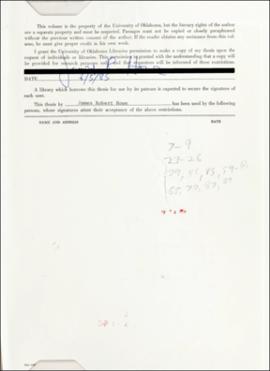| dc.contributor.author | Howe, James R. | |
| dc.coverage.spatial | Arkansas | |
| dc.coverage.spatial | Tennessee | |
| dc.coverage.spatial | Missouri | |
| dc.coverage.spatial | Kentucky | |
| dc.date.accessioned | 2023-01-19T18:00:15Z | |
| dc.date.available | 2023-01-19T18:00:15Z | |
| dc.date.created | 1985 | |
| dc.date.issued | 1985 | |
| dc.identifier.uri | https://hdl.handle.net/11244/336989 | |
| dc.description | Thesis (M.S.)--University of Oklahoma, 1985. | |
| dc.description.abstract | The Reelfoot aulacogen, an early Paleozoic failed-rift basin, lies concealed beneath the Gulf Coastal Plain strata of the upper Mississippi Embayment. Many similarities exist between the geologic history of the Reelfoot aulacogen and the coeval histories of the adjacent Paleozoic continental margins of North America. Plate tectonic theory provides useful concepts to explain the histories of both continental margins and intracratonic structural features.
Widespread continental extension (continental break-up) occurred in the latest Precambrian-Early Cambrian and initiated rifting in intracratonic areas. Rifting proceeded in some areas to drifting with generation of oceanic crust and formation of the Paleozoic continental margins of North America. Other areas, such as the Reelfoot rift, ceased rifting and subsided passively to form broad downwarped troughs above rift graben systems. Post-rifting subsidence in the Reelfoot area resulted primarily from cooling of the anomalous lithosphere that formed beneath the rift during extension and corresponds to post-rifting, passive subsidence of the continental margins.
Convergent plate interactions affect the interiors of continents as well as their margins, especially along lines of pre-existing weakness. Late Paleozoic plate convergences and continental collisions caused both compressive and extensional reactivation of certain ancient normal faults in the Reelfoot aulacogen that had formed initially during rifting. Post-Paleozoic faulting, generally related to reactivated basement normal faults, occurred in the Late Cretaceous, Tertiary, and Quaternary. Earthquakes in the Reelfoot aulacogen indicate continued faulting that results from the present-day stress field acting on certain ancient crustal weaknesses, usually reactivated rift stage faults.
The hydrocarbon potential of the Reelfoot area is discussed in terms of source rocks, reservoirs, and traps. Potential hydrocarbon prospects include broad anticlines, horst block highs, forced and compaction folds over block edges, normal and reverse faulted anticlines, submarine fans, carbonate buildups and shoals, stratigraphic pinchouts, truncation traps, unconformities, fracture reservoir trends, and shelf-basin hingelines. Reflection seismic profiles show examples of prospect types. | |
| dc.format.extent | xi, 109 leaves | |
| dc.format.medium | xi, 109 leaves : ill., maps (some col. and folded) ; 29 cm. | |
| dc.language.iso | eng | |
| dc.subject.lcsh | Petroleum--Geology--Arkansas | |
| dc.subject.lcsh | Petroleum--Geology--Tennessee | |
| dc.subject.lcsh | Petroleum--Geology--Missouri | |
| dc.subject.lcsh | Petroleum--Geology--Kentucky | |
| dc.title | Tectonics, sedimentation, and hydrocarbon potential of the Reelfoot aulacogen | |
| dc.type | Text | |
| dc.contributor.committeeMember | [Illegible] | |
| dc.contributor.committeeMember | Ralph [Illegible] | |
| dc.contributor.committeeMember | [Illegible] | |
| ou.group | School of Geology and Geophysics | |
